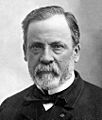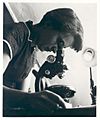List of biologists facts for kids
Do you know what a biologist does? Biologists are scientists who study living things! They explore everything from tiny cells to huge ecosystems. They help us understand how plants grow, how animals behave, and how our own bodies work. This list introduces some amazing biologists who made big discoveries. Their work helps us learn more about life on Earth.
Contents
Pioneers in Biology
These scientists laid the groundwork for many things we know today. They helped us understand the basic rules of life.
Ancient Thinkers
- Aristotle (384 BC–322 BC): This Greek philosopher was one of the first to study animals and plants in a scientific way. He observed many living things and tried to classify them.
Early Discoveries
- Antoni van Leeuwenhoek (1632–1723): A Dutch biologist, he was a master at making microscopes. He was the first to see tiny living things like bacteria and blood cells. Imagine seeing a whole new world through a lens!
- Robert Hooke (1635–1703): This British scientist was the first to use the word "cell" to describe the basic units of life. He saw them when looking at cork through his microscope.
- Carl Linnaeus (1707–1778): A Swedish botanist, Linnaeus created the system we still use today to name living things. It's called binomial nomenclature, giving each species two names (like Homo sapiens for humans).
- Georges Cuvier (1769–1832): This French naturalist was a pioneer in studying fossils. He helped us understand that many species have gone extinct over time.
Understanding Evolution
Evolution is how living things change over many generations. These biologists helped us understand this amazing process.
- Jean-Baptiste Lamarck (1744–1829): A French evolutionist, he was one of the first to suggest that living things change over time. He even helped coin the term "biology."
- Charles Darwin (1809–1882): This famous British naturalist wrote On the Origin of Species. His book explained how living things evolve through a process called natural selection. This idea changed science forever.
- Alfred Russel Wallace (1823–1913): A British naturalist, Wallace independently came up with the idea of natural selection at the same time as Darwin. They both presented their ideas together.
- Thomas Henry Huxley (1825–1895): An English zoologist, Huxley was a strong supporter of Darwin's theory of evolution. He helped explain these new ideas to the public.
- Ernst Mayr (1904–2005): An evolutionary biologist, Mayr helped shape our modern understanding of how new species form.
Genetics and Heredity
Genetics is the study of how traits are passed down from parents to children. These scientists unlocked the secrets of DNA and inheritance.
- Gregor Mendel (1822–1884): Often called the "father of genetics," this Czech-Austrian monk studied pea plants. He discovered the basic rules of how traits like height or color are inherited.
- Thomas Hunt Morgan (1868–1945): An American geneticist, Morgan studied fruit flies. He showed that genes are located on chromosomes, tiny structures inside cells.
- Oswald Avery (1877–1955): An American physician, Avery showed that DNA, not protein, carries genetic information. This was a huge step in understanding heredity.
- Rosalind Franklin (1920–1958): A British chemist, Franklin used X-ray images to study DNA. Her work was crucial in helping others figure out DNA's structure.
- James D. Watson (born 1928): An American biologist, Watson, along with Francis Crick, discovered the double helix structure of DNA. This discovery was a major breakthrough in biology.
- Francis Crick (1916–2004): A British molecular biologist, Crick, with James Watson, figured out the structure of DNA. This discovery explained how genetic information is stored and copied.
- Barbara McClintock (1902–1992): An American biologist, McClintock discovered "jumping genes" (transposons). These are pieces of DNA that can move around within a cell's genome.
- Sydney Brenner (born 1927): A British molecular biologist, Brenner did important work on genetics using a tiny worm called C. elegans. He helped us understand how genes control development.
- Kary Mullis (born 1944): An American biochemist, Mullis invented the Polymerase Chain Reaction (PCR). This technique allows scientists to make millions of copies of a specific DNA segment, which is super useful in many areas of biology.
Microbiology and Medicine
Microbiology is the study of tiny living things like bacteria and viruses. These scientists made discoveries that changed medicine and saved lives.
- Louis Pasteur (1822–1895): A French biochemist, Pasteur showed that germs cause diseases. He also developed pasteurization, a process that kills harmful microbes in food and drinks.
- Robert Koch (1843–1910): A German physician and bacteriologist, Koch identified the bacteria that cause diseases like tuberculosis and cholera. His work helped create modern bacteriology.
- Alexander Fleming (1881–1955): A British medical scientist, Fleming discovered penicillin, the first antibiotic. This medicine revolutionized how we treat bacterial infections.
- Howard Walter Florey (1898–1968): An Australian pharmacologist, Florey, along with Ernst Chain, helped turn penicillin into a widely available medicine.
- Jonas Salk (1914–1995): An American biologist, Salk developed the first effective polio vaccine. This vaccine helped nearly wipe out a terrible disease.
- June Dalziel Almeida (1930–2007): A Scottish virologist, Almeida was a pioneer in identifying human viruses using electron microscopy. She even helped identify the first human coronavirus.
- Luc Montagnier (born 1932): A French biologist, Montagnier was one of the scientists who discovered the Human Immunodeficiency Virus (HIV), which causes AIDS.
- Barry Marshall (born 1951): An Australian physician, Marshall, with Robin Warren, discovered that bacteria cause most stomach ulcers. This changed how doctors treat ulcers.
Ecology and Conservation
Ecology is the study of how living things interact with each other and their environment. Conservation is about protecting nature.
- John James Audubon (1786–1851): An American ornithologist (bird scientist), Audubon was famous for his detailed paintings of North American birds. He helped spark interest in bird conservation.
- Rachel Carson (1907–1964): An American biologist and author, Carson wrote Silent Spring. This book warned about the dangers of pesticides and helped start the modern environmental movement.
- Jane Goodall (born 1934): A British primatologist, Goodall spent decades studying chimpanzees in Africa. Her work taught us a lot about their social lives and behaviors.
- Dian Fossey (1932–1985): An American zoologist, Fossey dedicated her life to studying and protecting mountain gorillas in Rwanda. She helped raise awareness about their survival.
- Jacques-Yves Cousteau (1910–1997): A French marine biologist and explorer, Cousteau helped us explore the oceans. His documentaries showed the wonders of underwater life and inspired many to protect it.
- Sylvia Earle (born 1935): An American oceanographer, Earle is a passionate advocate for ocean conservation. She has explored deep sea environments and works to protect marine ecosystems.
Other Notable Biologists
- Louis Agassiz (1807–1873): A Swiss zoologist, Agassiz was a major figure in natural history. He studied fish and glaciers.
- Claude Bernard (1813–1878): A French physiologist, Bernard is known as the "father of modern physiology." He developed the idea of homeostasis, how our bodies keep a stable internal environment.
- Santiago Ramón y Cajal (1852–1934): A Spanish histologist, Cajal is considered the "father of neuroscience." He showed that the brain is made of individual nerve cells called neurons.
- Ivan Pavlov (1849–1936): A Russian physiologist, Pavlov is famous for his work on conditioning, especially with dogs. He studied how animals learn and react.
- Konrad Zacharias Lorenz (1903–1989): An Austrian scientist, Lorenz was one of the founders of ethology, the study of animal behavior. He studied how animals learn and interact.
- George Washington Carver (1860–1943): An American botanist and inventor, Carver developed hundreds of uses for crops like peanuts and sweet potatoes. He helped farmers improve their land.
- Gerty Cori (1896–1957): An American biochemist, Cori was the first American woman to win a Nobel Prize in science. She and her husband studied how the body uses energy.
- Bernardo Houssay (1887–1971): An Argentine physiologist, Houssay won a Nobel Prize for his work on how hormones from the pituitary gland control blood sugar.
- Roger W. Sperry (1913–1994): An American neuropsychologist, Sperry won a Nobel Prize for his research on "split-brain" patients. This work showed how the two halves of the brain work differently.
Images for kids





